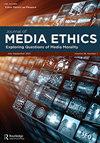The Politics of Communicating COVID in the United Kingdom
IF 1.1
3区 哲学
Q3 COMMUNICATION
引用次数: 0
Abstract
Like every country in the past two years, the United Kingdom has seen its fair share of COVID fake news in circulation. An early example in the first days of the pandemic was the rumor that the disease was spread by 5 G technology, a story that led to a number of masts being vandalized, significantly hampering the emergency services (Martin, 2020). A different strand of misinformation denied that COVID even existed or was far milder than had been claimed by the government. “Evidence” for views of this kind often involved videos of empty hospitals (Giles, Goodman, & Robinson, 2021), with believers arguing that the danger of the disease was being exaggerated in order to introduce draconian restrictions on personal liberty. More recently, the anti-vaccination movement has been strong enough to stage protests involving large numbers of people, some of which have led to violence, intimidating behavior and arrests (Gayle, 2021). However, the biggest challenge to public understanding and engaged debate on COVID-related issues was not necessarily posed by such blatant examples of misinformation. Instead, as academic research has shown, more significant is obfuscation in government communications and news reporting that failed to effectively contextualize the UK’s COVID response, particularly with international comparisons (Cushion, Morani, Kyriakidou, & Soo, 2021). The latter issue is particularly significant, as UK seems to have had a poor pandemic when its efforts were juxtaposed with similar countries. At the time of writing, the UK’s COVID death-rate per 100,000 people was 226.6. In France, the comparable figure was 188.4 in France and in Germany 138.9 (Financial Times, 2022). Despite his electoral success, it is hard to imagine a politician more ill-suited to the requirements of sober public health communication than Boris Johnson, a former journalist, controversialist and television panel show guest. Examples of Johnson’s communication during the pandemic included a claim that the virus would be defeated in 12 weeks in March 2020, referring to the government’s desperate quest to source emergency ventilators as “operation last gasp,” and claiming that the UK’s procurement of personal protective equipment and the effectiveness of the country’s test and trace systems were “world-beating” (they provably were not). Perhaps in an effort to counteract these weaknesses, the government made notable use of experts in its COVID communication strategy. Civil service scientific officials regularly appeared in daily pandemic press conferences with elected politicians, with some – notably England’s Chief Medical Officer Professor Chris Whitty and Deputy Chief Medical Office Professor Jonathan Van-Tam – becoming household names. In the context of the recent history of the British political communication, this was a notable development. Famously in the 2016 EU Membership referendum campaign, leave supporter and Conservative cabinet minister Michael Gove claimed that “people of this country have had enough of experts” (Mance, 2016). Gove’s argument was self-serving (he was dismissing a particular set of economic models), but his observation became emblematic of broader decline in a technocratic, expert-led forms of political communication that seemed to be occurring across liberal democracies more generally (Waisbord,英国传播新冠肺炎的政治
像过去两年里的每个国家一样,英国也出现了不少假新闻。大流行最初几天的一个早期例子是,有传言称该疾病是通过5g技术传播的,这一传言导致许多桅杆遭到破坏,严重阻碍了应急服务(Martin, 2020)。另一种错误信息甚至否认了COVID的存在,或者比政府声称的要温和得多。这种观点的“证据”通常涉及空荡荡的医院的视频(Giles, Goodman, & Robinson, 2021),信教者认为,为了对个人自由施加严厉的限制,这种疾病的危险被夸大了。最近,反疫苗运动已经强大到足以发起涉及大量人的抗议活动,其中一些导致暴力,恐吓行为和逮捕(Gayle, 2021)。然而,公众对covid - 19相关问题的理解和参与辩论的最大挑战并不一定是由这些公然的错误信息造成的。相反,正如学术研究表明的那样,更重要的是政府沟通和新闻报道中的混淆,未能有效地将英国的COVID应对情况纳入背景,特别是与国际比较(Cushion, Morani, Kyriakidou, & Soo, 2021)。后一个问题尤其重要,因为当英国的努力与类似国家相提并论时,它的流行病似乎很糟糕。在撰写本文时,英国每10万人的COVID死亡率为226.6。在法国,可比较的数字是188.4,在法国和德国138.9(金融时报,2022)。尽管鲍里斯•约翰逊在选举中取得了成功,但很难想象有哪个政治家比鲍里斯•约翰逊(Boris Johnson)更不适合严肃的公共卫生传播要求。鲍里斯曾是一名记者、争议者和电视专题节目嘉宾。约翰逊在大流行期间的沟通例子包括声称该病毒将在2020年3月的12周内被击败,称政府迫切需要采购紧急呼吸机是“最后一次行动”,并声称英国采购的个人防护装备和该国测试和追踪系统的有效性是“世界一流的”(事实证明并非如此)。也许是为了克服这些弱点,政府在其COVID沟通战略中显著利用了专家。公务员科学官员经常与当选的政治家一起出席每日的流行病新闻发布会,其中一些人——特别是英格兰首席医疗官克里斯·惠蒂教授和副首席医疗办公室教授乔纳森·范·塔姆——成为家喻户晓的人物。在英国政治传播近代史的背景下,这是一个显著的发展。众所周知,在2016年欧盟成员国公投运动中,脱欧支持者、保守党内阁大臣迈克尔·戈夫(Michael Gove)声称“这个国家的人民已经受够了专家”(Mance, 2016)。戈夫的观点是自私自利的(他否定了一套特定的经济模型),但他的观察成为了技术官僚、专家主导的政治沟通形式更广泛衰落的象征,这种形式似乎正在更普遍地发生在自由民主国家(韦斯博德,
本文章由计算机程序翻译,如有差异,请以英文原文为准。
求助全文
约1分钟内获得全文
求助全文

 求助内容:
求助内容: 应助结果提醒方式:
应助结果提醒方式:


